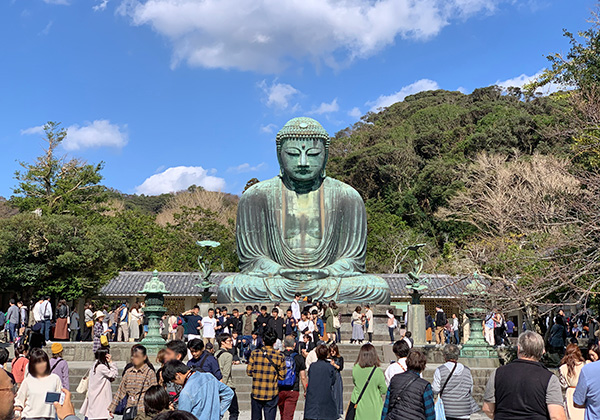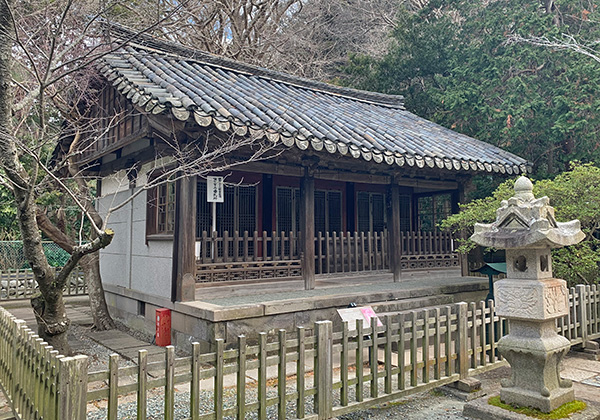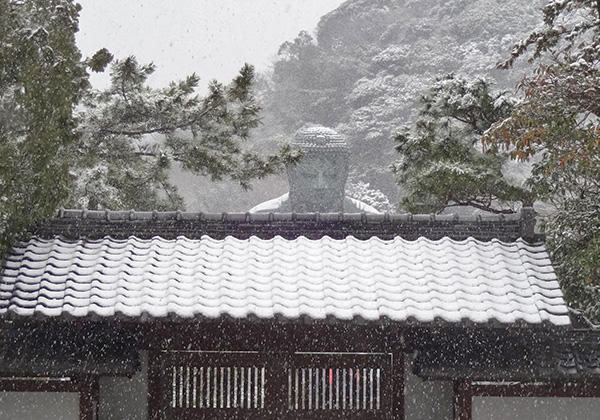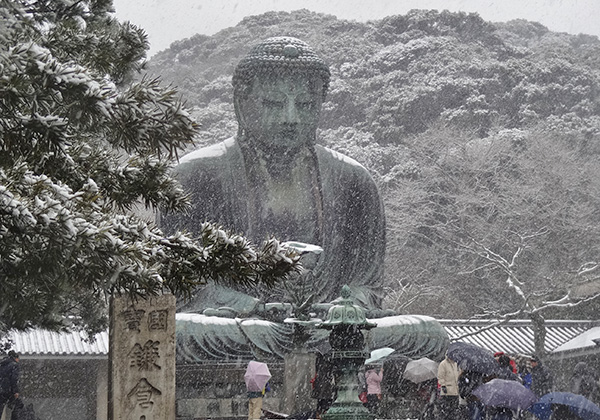Kotokuin
| Official Name | Taiisan Kotokuin Shojo Senji {Pronounced tye-e-san koh-tok-in shoh-joe sen-gee} Daibutsu {dye-boo-tsu} |
|---|---|
| Religious sect | Jodo sect, Buddhism |
| Founded | in circa 1243 by unknown |
| Address | 2-28 Hase 4-chome, Kamakura, Kanagawa 248-0015 (show route from current location ) |
| Location | 1,400 meters west of Kamakura Station |
| Time needed to get there | 20 minutes |
| Admission | JPY300 |
| Open | April-September: 8:00-17:30 October - March: 8:00-17:00 |
| Phone number | 0467-22-0703 |
| Restrooms | Available |
| Note | Temporary closure of entry to the interior of the Great Buddha statue. |
Historical Overview
Microsoft's Encarta Encyclopedia introduces this cast-in-bronze statue as "the city's most celebrated landmark". Grolier encyclopedia also says the statue is "the historic landmark". To any Japanese who refer to Kamakura, the first thing that crosses their mind would probably be this Great Buddha or Daibutsu as is commonly called. In fact, it is a National Treasure and one of the centerpieces of the city's cultural heritages.
What was the motive and who instructed to build such a huge statue? When the Great Buddha Statue of Todaiji in Nara Prefecture was reconstructed in 1195, Yoritomo Minamoto {yoh-re-toh-moh me-nah-moh-toh} (1147-1199), the founder of the Kamakura Shogunate, participated the inauguration together with his wife Masako {mah-sah-koh} (1157-1225). Seeing the colossal statue, he felt like building a matching one in Kamakura to demonstrate his power. But his wish never came true as he died four years later in 1199.
Yoritomo's court lady named "Inada" {e-nah-dah}, however, tried to materialize Yoritomo's wish. She obtained an approval from Masako to go ahead with the project and asked Priest Joko {joe-koh} (his and Inada's birth and death years unknown), to travel across the country in search of alms, in other words, to solicit donations. The Kamakura Shogunate, then controlled by Hojo regents, did not give financial aids to the project because they patronized mainly Zen temples, whereas the Statue they were aiming at was that of Amida (Amitabha in Sanskrit), which was venerated by Jodo sect Buddhists. Added to that, Tokiyori Hojo {toh-kee-yoh-re hoh-joe} (1227-1263), then the fifth Hojo Regent, was busy building Kenchoji.
Selection of this site, western part of Kamakura, to enshrine the Statue also reflected Jodo sect sentiment and their belief that the Lord of Pure Land Paradise dwells in the far west.
Priest Joko went on a fund-raising trip as a mendicant priest in March 1238, and he collected necessary funds at long last after going through many hardships. Construction of the Statue as well as its hall were completed in 1243. However, it was not like the present-day bronze statue, but a wooden one with its head's girth as large as 24 meters.
Unfortunately, it was completely wrecked by a violent storm in 1247. Five years later in 1252, thanks again to the fund-raising campaign by Lady Inada and Priest Joko, construction of a new statue, not a wooden but bronze one this time, began with caster Hisatomo Tanji {he-sah-toh-moh tan-gee} (birth and death years unknown) and Goro-emon Ono {go-roe-a-mon oh-no} (ditto). It took them more than a dozen years to finish up. The Great Buddha Statue we see today in the Temple is the one made at that time, though the exactly time of completion remains obscure. Distinct from the statue in Todaiji is that the Statue here was built totally with the funds donated by the devotees and well-wishers, getting no governmental or official aid whatsoever.
To commemorate Lady Inada's contribution, there is her cenotaph standing in the courtyard.
The Statue was originally housed in a large wooden building like the one in Todaiji. However, it was caught in another storm in 1335 and the building was completely ruined. The Kamakura Shogunate had fallen two years earlier and the area was still a battlefield between the new-comers and the remnants of the Hojo troops. When the typhoon hit the area, no fewer than 500 samurai of the Hojos sought refuge in the building. Unfortunately, most of them were crushed to death, says the record, as the building collapsed.
In 1495, the area suffered again from the calamity of earthquake and ensuing tsunami wave. The newly constructed building was severely damaged once more. But, the Statue was all right. Back at the time, the government was no longer in Kamakura but in Kyoto under the Ashikaga Shogunate. They did not give a hand for reconstruction. The Statue has since never been housed, and has been sitting in the open air, weather-beaten, over 700 years up to now. Reminiscent of the old building are the foundation-stones that are found here and there behind the gallery.
The Statue had sometimes been left in natural erosion and neglect. As a matter of fact, it fell into disrepair to a point where the homeless and gamblers lived inside, making it as their den. Saddened by the deteriorating condition, a priest Yuten Ken'yo {you-ten ken-yoh} (1637-1718) by name at Zojoji in Tokyo, one of the seven main temples of Jodo Sect, tried to restore the old day glory of the Statue. His plan was not only to repair the Statue but also to build a large hall same time. He began to solicit contributions in 1712. Though the fund he collected was not enough to cover the construction cost of a new building, it was enough to revamp the Statue. Without his efforts, it might have been broken down by now.
In commemoration of the efforts exerted by Priest Yuten and major contributors, there are four round-shaped (lotus pedals) bronze plates lying just behind the Statue, on which donators' names are engraved. Minor repairs were made twice in recent years; one in 1923 after the Great Kanto Earthquake by which the base of the Statue was damaged, and the other in 1960. The latter was to reinforce the neck part as well as the base so that it can survive should a similar-size earthquake shake.
Except for the Nio-mon gate or the two Deva Kings (the guardian gods of temple) at the entrance, Kotoku-in does not look like an Buddhist temple. First of all, there is no graveyard in sight. It looks more like a park with a statue of a hero placed in the center. But, when Buddhists from Asian countries where the Theravada Buddhism is prevailing visit here, they never fail to prostrate themselves and pray to the Statue.
The real Kotokuin temple, meanwhile, sits east of the gallery, but it is off-limits to occasional visitors.
Richard Cocks (1566-1624), a commercial attache of England stationed in Nagasaki city for ten years, once visited here in 1616. He was quoted as saying that the Statue must be larger than the Colossus of Rhodes, one of the Seven Wonders of the Ancient World. In view of the Statue standing over 700 years without collapsing, it may deserve to be ranked the 8th wonder of the ancient world.
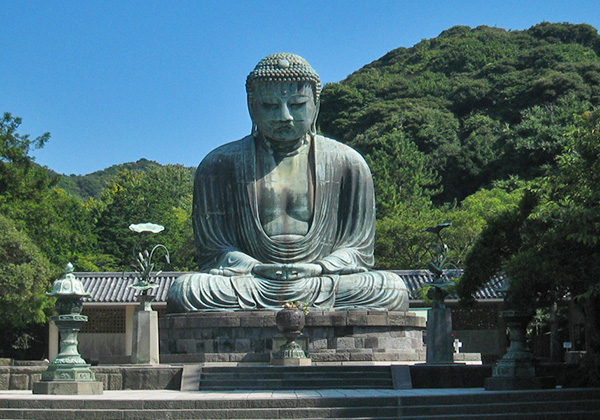
How big is the Statue ?
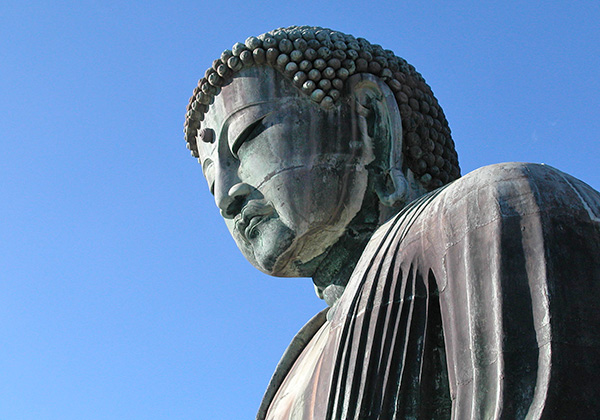
The Statue is roughly seven-tenths the size of the Great Buddha Statue in Todaiji, Nara. The following are measurements by parts in meter:
Kangetsudo {kan-gets-doh} Hall
In the backyard behind the gallery is a sub-temple named Kangetsudo {kan-gets-doh}, literally meaning a moon-viewing hall. It was brought from Korea in 1934. Enshrined inside the hall is a statue of Sho Kan'non or Arya-avalokitesvara in Skt., which was fashioned during the Edo Period (1603-1868). It ranks last of the Thirty-Three Kamakura Kan'non Pilgrimage. Sculptor unknown. This sub-temple was originally consecrated to the memory of Priest Yuten.
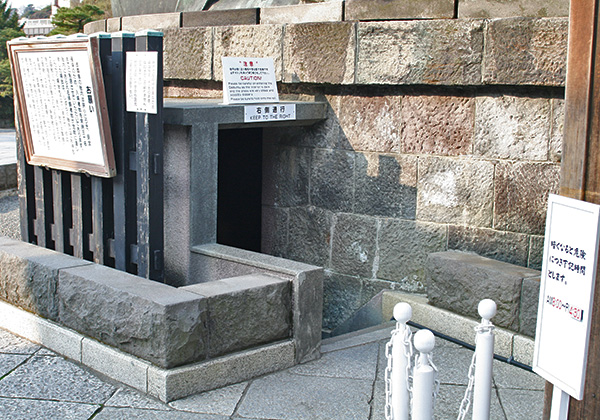
Stone-marker of a Tanka-poet
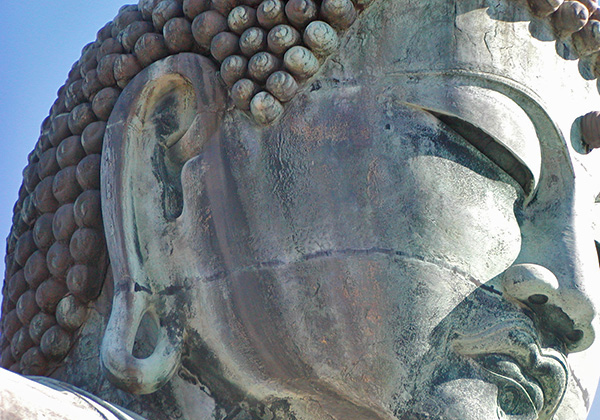
On the right-hand side of the Kangetsudo hall stands a stone marker, on which a tanka written by Akiko Yosano {ah-kee-koh yoh-sah-noh} (1878-1942), a famous poetess, is inscribed. Tanka is a 31-syllable verse consisting of five metrical units of 5, 7, 5, 7 and 7 syllables respectively. Though the letters are blurring, it reads:
Ka-ma-ku-ra-ya {kah-mah-koo-rah-yah}
Mi-ho-to-ke-na-re-do {me-hoh-toh-keh-nah-reh-doh}
Sha-ka-mu-ni-wa {shah-kah-moo-nee-wah}
Bi-na-n-ni-o-wa-su {be-nan-nee-oh-wah-soo}
Na-tsu-ko-ad-chi-ka-na {nah-tsu-koh-dah-chee-kah-nah}
This tanka depicts her first impression when she saw the Statue. It was summer and she felt it looked like a good-looking Shaka (Sakyamuni in Skt.). Strictly speaking, however, she was wrong. The Statue is not Sakyamuni but Amida. This story is well known and quoted even in a 1949 novel written by Yasunari Kawabata {yah-soo-nah-re kah-wah-bah-tah} (1899-1972), a Nobel prize-winning writer, entitled The Sound of the Mountains (1949), in which he gave a picture of a family in Kamakura during the 1930s. An elderly couple have a son who just married and they are living together in the same house. The son has adulterous affairs and his father comforts the daughter-in-law, trying also to separate the son from a woman he has affairs with. Relationship between the son and his wife, though a quiet woman she is, becomes so destructive that she has an abortion. But she relies on her father-in-law spiritually. The story written in beautiful language really warms the heart of the readers. Somewhere in the latter half of the story, the family take a stroll around the Great Buddha, and the father point out that "Sakyamuni" in Akiko Yosano's tanka is not correct.
